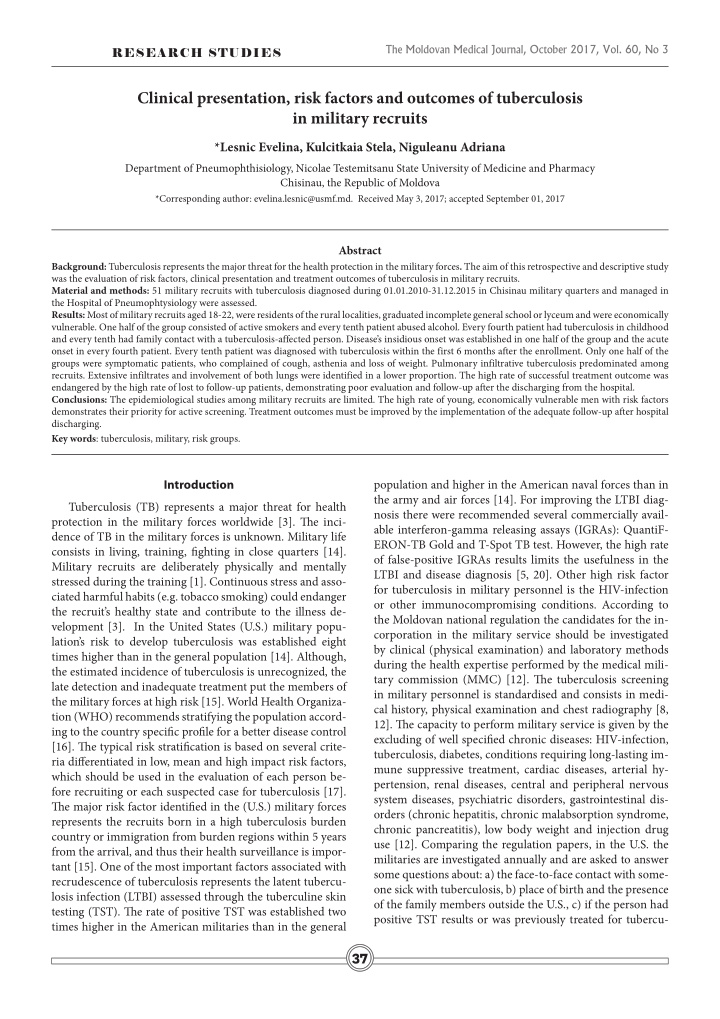



The Moldovan Medical Journal, October 2017, Vol. 60, No 3 RESEARCH STUDIES Clinical presentation, risk factors and outcomes of tuberculosis in military recruits *Lesnic Evelina, Kulcitkaia Stela, Niguleanu Adriana Department of Pneumophthisiology, Nicolae Testemitsanu State University of Medicine and Pharmacy Chisinau, the Republic of Moldova *Corresponding author: evelina.lesnic@usmf.md. Received May 3, 2017; accepted September 01, 2017 Abstract Background: Tuberculosis represents the major threat for the health protection in the military forces . The aim of this retrospective and descriptive study was the evaluation of risk factors, clinical presentation and treatment outcomes of tuberculosis in military recruits. Material and methods: 51 military recruits with tuberculosis diagnosed during 01.01.2010-31.12.2015 in Chisinau military quarters and managed in the Hospital of Pneumophtysiology were assessed. Results: Most of military recruits aged 18-22, were residents of the rural localities, graduated incomplete general school or lyceum and were economically vulnerable. One half of the group consisted of active smokers and every tenth patient abused alcohol. Every fourth patient had tuberculosis in childhood and every tenth had family contact with a tuberculosis-affected person. Disease’s insidious onset was established in one half of the group and the acute onset in every fourth patient. Every tenth patient was diagnosed with tuberculosis within the first 6 months after the enrollment. Only one half of the groups were symptomatic patients, who complained of cough, asthenia and loss of weight. Pulmonary infiltrative tuberculosis predominated among recruits. Extensive infiltrates and involvement of both lungs were identified in a lower proportion. The high rate of successful treatment outcome was endangered by the high rate of lost to follow-up patients, demonstrating poor evaluation and follow-up after the discharging from the hospital. Conclusions: The epidemiological studies among military recruits are limited. The high rate of young, economically vulnerable men with risk factors demonstrates their priority for active screening. Treatment outcomes must be improved by the implementation of the adequate follow-up after hospital discharging. Key words : tuberculosis, military, risk groups. Introduction population and higher in the American naval forces than in the army and air forces [14]. For improving the LTBI diag- Tuberculosis (TB) represents a major threat for health nosis there were recommended several commercially avail- protection in the military forces worldwide [3]. Ti e inci- able interferon-gamma releasing assays (IGRAs): QuantiF- dence of TB in the military forces is unknown. Military life ERON-TB Gold and T-Spot TB test. However, the high rate consists in living, training, fj ghting in close quarters [14]. of false-positive IGRAs results limits the usefulness in the Military recruits are deliberately physically and mentally LTBI and disease diagnosis [5, 20]. Other high risk factor stressed during the training [1]. Continuous stress and asso- for tuberculosis in military personnel is the HIV-infection ciated harmful habits (e.g. tobacco smoking) could endanger or other immunocompromising conditions. According to the recruit’s healthy state and contribute to the illness de- the Moldovan national regulation the candidates for the in- velopment [3]. In the United States (U.S.) military popu- corporation in the military service should be investigated lation’s risk to develop tuberculosis was established eight by clinical (physical examination) and laboratory methods times higher than in the general population [14]. Although, during the health expertise performed by the medical mili- the estimated incidence of tuberculosis is unrecognized, the tary commission (MMC) [12]. Ti e tuberculosis screening late detection and inadequate treatment put the members of in military personnel is standardised and consists in medi- the military forces at high risk [15]. World Health Organiza- cal history, physical examination and chest radiography [8, tion (WHO) recommends stratifying the population accord- 12]. Ti e capacity to perform military service is given by the ing to the country specifj c profj le for a better disease control excluding of well specifj ed chronic diseases: HIV-infection, [16]. Ti e typical risk stratifj cation is based on several crite- tuberculosis, diabetes, conditions requiring long-lasting im- ria difg erentiated in low, mean and high impact risk factors, mune suppressive treatment, cardiac diseases, arterial hy- which should be used in the evaluation of each person be- pertension, renal diseases, central and peripheral nervous fore recruiting or each suspected case for tuberculosis [17]. system diseases, psychiatric disorders, gastrointestinal dis- Ti e major risk factor identifj ed in the (U.S.) military forces orders (chronic hepatitis, chronic malabsorption syndrome, represents the recruits born in a high tuberculosis burden chronic pancreatitis), low body weight and injection drug country or immigration from burden regions within 5 years use [12]. Comparing the regulation papers, in the U.S. the from the arrival, and thus their health surveillance is impor- militaries are investigated annually and are asked to answer tant [15]. One of the most important factors associated with some questions about: a) the face-to-face contact with some- recrudescence of tuberculosis represents the latent tubercu- one sick with tuberculosis, b) place of birth and the presence losis infection (LTBI) assessed through the tuberculine skin of the family members outside the U.S., c) if the person had testing (TST). Ti e rate of positive TST was established two positive TST results or was previously treated for tubercu- times higher in the American militaries than in the general 37
Recommend
More recommend